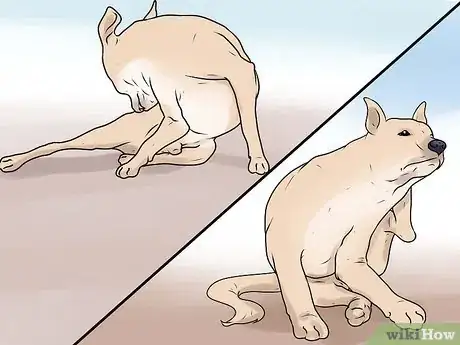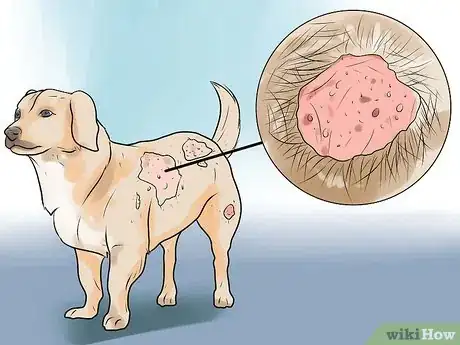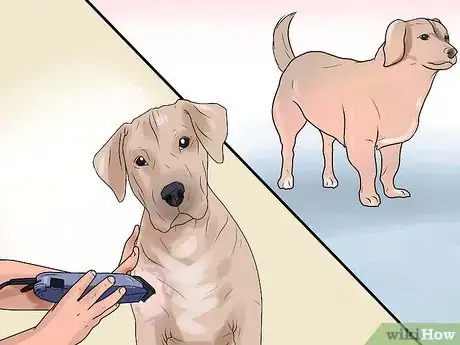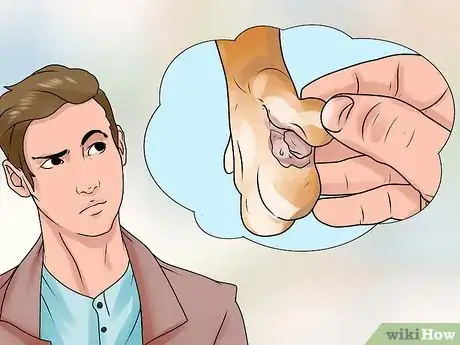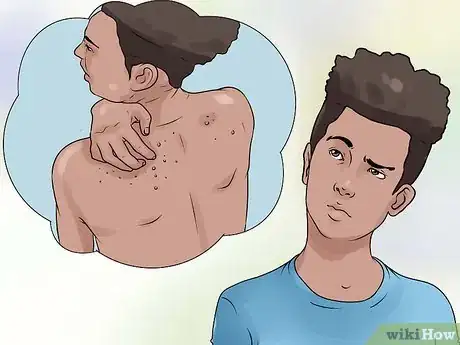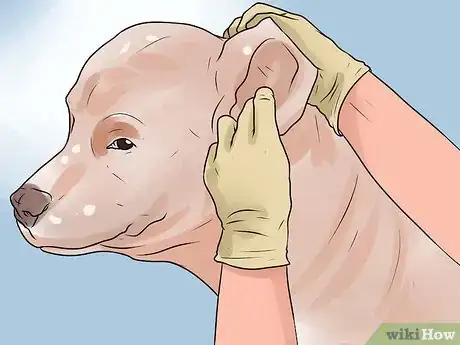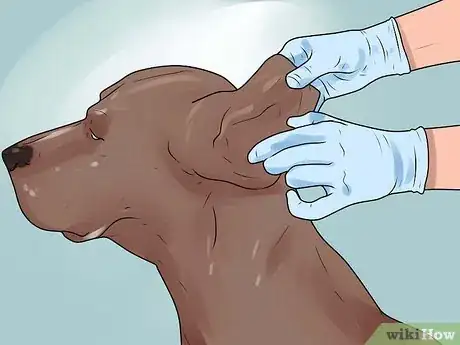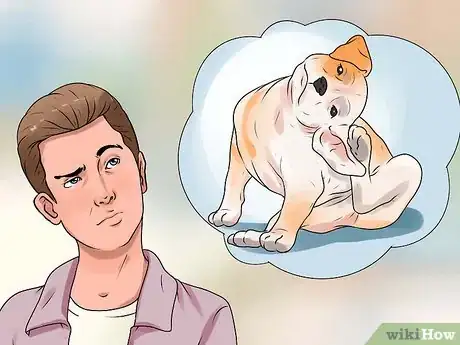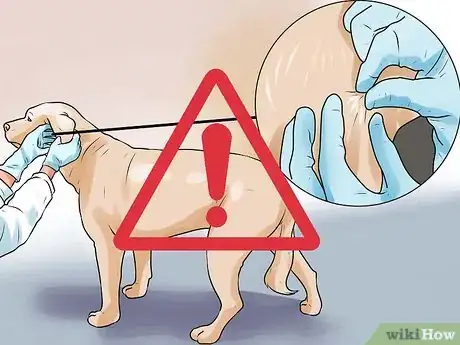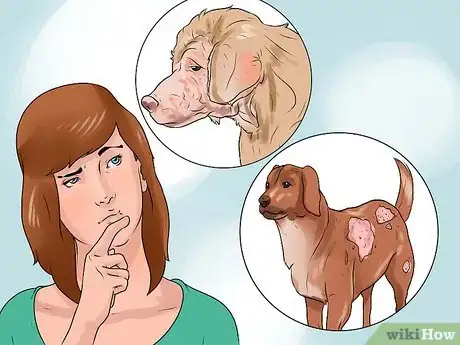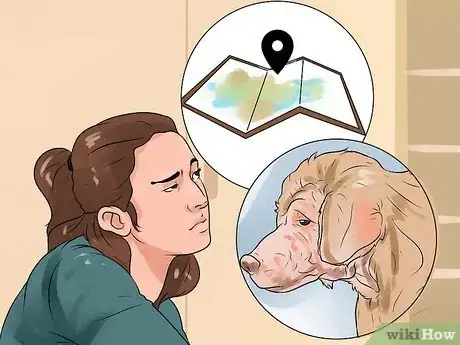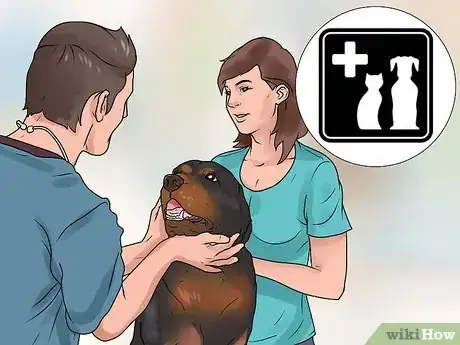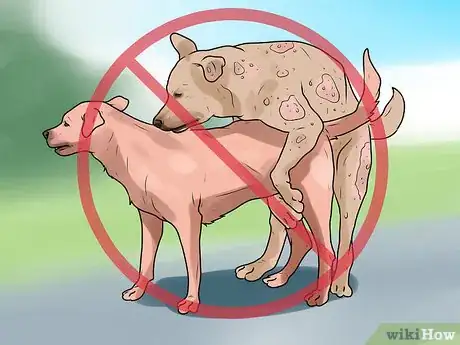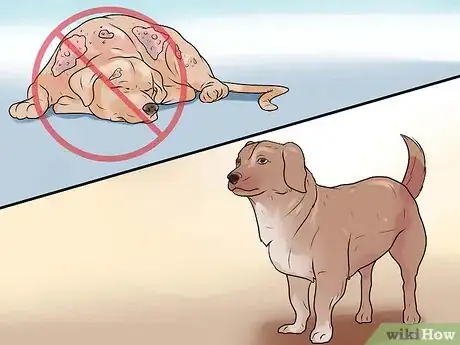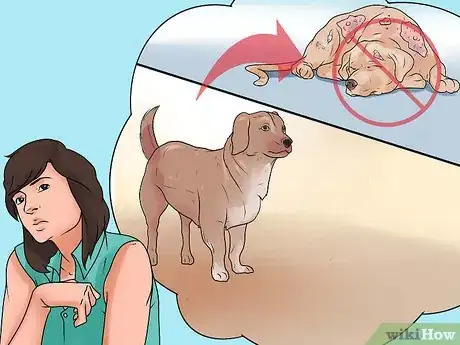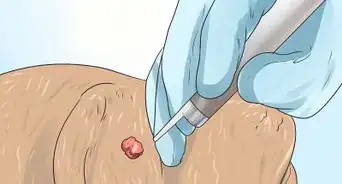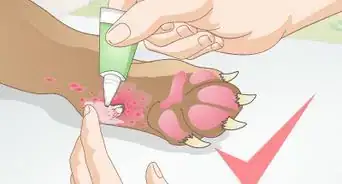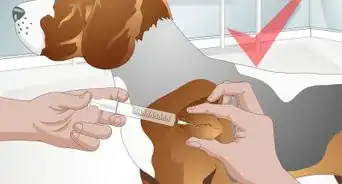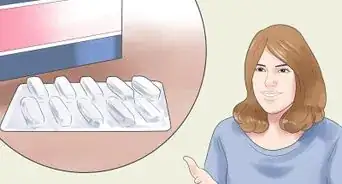This article was co-authored by Ray Spragley, DVM. Dr. Ray Spragley is a Doctor of Veterinary Medicine and the Owner/Founder of Zen Dog Veterinary Care PLLC in New York. With experience in multiple institutions and private practices, Dr. Spragley’s specializations and interests include non-surgical management of cranial cruciate ligament tears, Intervertebral Disk Disease(IVDD), and pain management in osteoarthritis. Dr. Spragley holds a BS in Biology from SUNY Albany and has a Doctor of Veterinary Medicine degree (DVM) from Ross University School of Veterinary Medicine. He is also a Certified Canine Rehabilitation Therapist (CCRT) through the Canine Rehab Institute as well as a Certified Veterinary Acupuncturist (CVA) through Chi University.
There are 9 references cited in this article, which can be found at the bottom of the page.
wikiHow marks an article as reader-approved once it receives enough positive feedback. This article received 24 testimonials and 95% of readers who voted found it helpful, earning it our reader-approved status.
This article has been viewed 2,178,295 times.
Mange is a type of inflammatory skin disease caused by tiny parasitic mites on dogs. There are two basic types of mange, sarcoptic and demodectic, which have separate causes and symptoms. It is important to be able to identify the signs of each, and to understand the difference between them. Though mange is rarely fatal, knowing how to recognize this frustrating disease early makes treating the dog much easier in the long run.
Things You Should Know
- Look out for itching, hair loss, and swollen feet on your pup, as these are classic symptoms of mange.
- Search for signs of mange on yourself and other members of your household as well—typically, they present as red bumps.
- If your dog does have mange, take them to the vet. Then, wash your pet's items (like their leash, collar, and bedding) with bleach or borax.
Steps
Recognizing Symptoms of Mange
-
1Look for intense itching. Sarcoptic mange usually causes frantic itching.[1] The dog may relentlessly scratch or chew at its skin to relieve the itch. The dog's skin, irritated from the constant scratching and biting, can easily become infected. The itching can even be so severe that it distracts the dog from necessary behavior like eating, drinking, and resting.
- Severe cases of sarcoptic mange that result in secondary infections from bacteria or yeast can cause a white, crusty surface to form on the dog's irritated skin, though this does not occur in all cases.[2] In addition, dogs with severe secondary infections will also often suffer weight loss, run a fever, and/or have enlarged lymph nodes.
EXPERT TIPDr. Elliott, BVMS, MRCVS is a veterinarian with over 30 years of experience in veterinary surgery and companion animal practice. She graduated from the University of Glasgow in 1987 with a degree in veterinary medicine and surgery. She has worked at the same animal clinic in her hometown for over 20 years.Veterinarian
 Pippa Elliott, MRCVS
Pippa Elliott, MRCVS
VeterinarianDid You Know? Mange mites are too small to see with the naked eye. If you can see an insect on the dog, then it's not a type of mite and isn't mange. This will require a different treatment.
-
2Check for hair loss.[3] Localized demodectic mange, the least serious variety, usually results in one or two "thin" or bald patches in the dog's hair. Usually, this small patch will not appear inflamed or irritated and will not cause serious itching. [4]Advertisement
-
3Note the extent of bald spots or hair loss. If a case of localized demodectic mange does not go away on its own, it may eventually spread to the rest of the dog's body, resulting in generalized mange. The dog will develop numerous thin or bald patches over its body. Existing patches may grow to about 1 inch (2.5 cm) in diameter. The skin in the patches may become red, scaly, and/or crusty.
-
4Inspect your dog's feet to see if they're swollen or irritated. Some select cases of demodectic mange cause a condition called demodectic pododermatitis. This occurs when the mites that cause mange become deeply embedded in the dog's feet, where they are very difficult to remove. This condition most often presents itself in the form of swollen, irritated feet. It is usually worst around the nailbeds and often accompanied by a secondary infection.[7]
-
5Look for patches of red, irritated bumps on yourself or others in your household. One of the ways to detect a case of mange on your dog is to find mite bites on yourself. When the type of mites that cause sarcoptic mange come into contact with a human, they can cause red bumps similar to mosquito bites.[8] Luckily, these almost never become serious. However, seeing these symptoms after being around a dog that can't stop scratching itself is a strong indication of sarcoptic mange.
- Note that humans cannot get the type of mites that cause demodectic mange.
-
6Note that the signs of mange could also be signs of other, possibly serious, conditions. Itching or patchy hair loss are also symptoms of other underlying health issues, such as allergies, hyperadrenocorticism (Cushing's disease), diabetes, hyperthyroidism, and parasite infection. Therefore, it is important to consult your veterinarian about the problem in order to get a proper diagnosis and treatment.[9]
Testing for Sarcoptic Mange
-
1Grab hold of one of the dog's ears. If your dog appears to be itching itself more than normal but you're unsure whether it has sarcoptic mange, this simple test can help. To start, take one of your dog's ears gently in your hand. Hold the loose, floppy part of the ear between your thumb and index finger.
- If you're worried about the possibility of getting bitten by your dog's mange-causing mites, you may want to wear disposable gloves for this test.
-
2Gently rub the ear between your fingers. Use your thumb and index finger to rub the dog's ear from both sides. Use slow, steady movements and don't squeeze too tightly. While you do this, keep your eyes on the dog's hind leg on the same side as the ear you're rubbing.
-
3Look for an itching motion. You're looking for a movement in the dog's hind leg like it's trying to reach up to scratch its ear. If you see this, your dog may have sarcoptic mange. In this case, you should wash your hands and take the dog to a veterinarian at your earliest convenience.
- This test (called the pinnal-pedal reflex test) works because, in the vast majority of sarcoptic mange cases, mites are present in and around the dog's ears. When you rub the dog's ear, it feels the irritating itching sensation caused by the mites and tries to scratch itself.
-
4Note that the pinnal-pedal reflex test does not give a definitive diagnosis of sarcoptic mange. While the test does confirm your dog is itchy and sensitized, it does not confirm the cause. Sarcoptic mange can be very difficult to definitively diagnose. The pinnal-pedal test may lead to a presumptive diagnosis of scabies, in which case treatment should begin as soon as possible. If your dog responds to the therapy promptly, that is considered confirmation of the diagnosis.
Understanding the Different Types of Mange
-
1Differentiate between sarcoptic and demodectic mange. Dogs can contract two forms of mange — sarcoptic mange and demodectic mange. Though both can be serious, the two forms of the disease differ somewhat in the symptoms they present (see Part 1) and have different causes. Sarcoptic mange is an infection by a specific kind of mite that is passed along from other infected animals. Demodectic mange is caused by a different kind of mite that is normally present in a dog's skin. While most dogs live in harmony with these mites, sometimes the mites can proliferate and cause hair loss and irritation. [10]
- Although both sarcoptic and generalized demodectic mange can lead to itching, it's important to distinguish the two — the mites that cause sarcoptic mange lead to immediate, severe itching, while the mites that cause demodectic mange cause patches of irritated skin to develop, which then may become itchy.[11]
- While sarcoptic mange itself can't kill a dog, the dog's health can deteriorate quickly if it gets a serious infection or stops eating or sleeping, so, in this case, immediate veterinary care may be needed. This should be obvious — a dog with a bad case of sarcoptic mange will appear profoundly unhealthy.
- Sarcoptic mange is sometimes referred to as scabies.[12]
- Demodectic mange may also be called Demodex.[13]
-
2Understand the difference between localized and generalized demodectic mange. Localized demodectic mange is characterized by hair loss in one or two spots. If unresolved (possibly because of suppressed immunity, allergies, or endocrine issues), the condition may spread, resulting in a proliferation of bald patches that may become irritated and infected, which lead to itching and scabbing.
- Localized demodectic mange is most common in puppies. In about 90% of cases, localized demodectic mange disappears on its own without treatment in a month or two.[14] However, in a fraction of cases, the disease may develop into the more serious generalized demodectic mange.
- While dogs do not inherit demodectic mange per se, is thought that those that develop generalized demodectic mange usually inherit their weakness to the disease genetically.[15]
-
3Learn to look for the signs of demodectic pododermatitis as early as possible. Pododermatitis is a third type of demodectic mange; in some cases the dog may have the classic symptoms of demodectic mange, while others may have foot infections only. Treatment of pododermatitis can be long and complicated, often involving administering antibiotics and frequently dipping the dog's feet in a medication called Mitaban.[16] Because treatment is difficult, spotting this condition early is critical.
Taking Initial Treatment and Prevention Steps
-
1Seek veterinary care. If you think your dog has any sort of mange, you should consult your veterinarian. Only a trained, experienced vet can run the proper diagnostic tests to determine the type and severity of the mange. Depending on the diagnosis, the vet will then prescribe the proper medication to treat the mange. Because mange is almost always easiest to treat before it becomes severe, seeing your vet as quickly as possible is important to ensure your pet is back to normal as soon as possible.
- Cases of sarcoptic mange require a veterinarian more urgently than demodectic mange. Because the severe itching from sarcoptic mange can make a dog miserable (and, more importantly, quickly lead to health problems), early diagnosis and treatment is essential.
- The exception to this general rule is for very minor cases of localized demodectic mange. Because these usually clear up on their own, a veterinarian is not always necessary, though you may want to consult with one for peace of mind anyway, and to rule out other conditions.
-
2Clean or replace the dog's bedding, collar, and so on. In cases of mange (especially sarcoptic mange, which is contagious), any objects that have recently come into contact with the dog's hair or skin should immediately be washed or replaced. This includes its bedding, collar, leash, harness, doghouse, and any brushes or cleaning products. The need for cleaning is especially urgent if you have other pets who don't have mange yet.
- For fabric objects, launder with bleach or borax and dry at the highest possible setting. For hard objects and surfaces, use a hospital-grade disinfectant. Repeat daily as needed until the mange subsides.
-
3Don't breed dogs with demodectic mange. As noted above, dogs who get bad cases of demodectic mange sometimes have a weakness in their immune system that they've inherited from their parents. Because of this, owners of dogs that have had long, severe, or difficult-to-treat cases of demodectic mange are usually encouraged not to breed their dogs. For dogs that have had minor, localized cases of demodectic mange, breeding is sometimes considered acceptable, especially if the mange occurred when the dog was young and cleared up on its own.
- It's worth noting, however, that some veterinarians will recommend against breeding dogs that have had any sort of demodectic mange.[17] If you're unsure of whether it's wise to breed your dog, talk to a vet who knows you and your dog for advice. Usually, a vet like this will be able to recommend a course of action that takes your needs into account as well as the health of any future puppies.
-
4Keep other animals away from a dog with sarcoptic mange. Because sarcoptic mange is highly contagious, quarantine is essential for making sure that other pets and animals don't catch the aggravating disease. If your dog has sarcoptic mange, immediately separate it from other animals.[18] Don't let it sleep, feed, or play near them. If you think a neighbor's dog has sarcoptic mange, don't let your own pets go near it. Once the mange has completely disappeared, the dog may be allowed to mingle with other animals as normal.
- Note that no form of demodectic mange is thought to be contagious to other animals or humans. In very rare cases, the disease may be contagious to other dogs. However, quarantine measures usually aren't taken even when symptoms are severe.[19]
-
5Understand the risk factors for catching sarcoptic mange. Sarcoptic mange is highly contagious and usually passed from one infected dog to another. Often the infected dog shows few, if any, signs of the disease. Sarcoptic mange may be passed from a mother to her puppies, and is common in overcrowded conditions where dogs are poorly maintained, such as puppy mills, boarding kennels, and shelters.[20] However, a dog might be exposed to mites even if it doesn't come into contact with a mangy animal: mites can survive four to 21 days away from their host in temperatures between 50-59 F (10-15 C), and two to six days in temperatures of 68-77 F (20-25 C).
- A dog could catch mange from an object that has recently been used on an infected animal, such as a blanket or towel. Likewise, if grooming salons do not practice regular sanitation of clippers, towels, and caging, this could also lead to the spread of the disease.[21]
- Since wild animals like coyotes and foxes can also get sarcoptic mange, exercising in wildlife areas may also expose your dog to scabies.
Expert Q&A
-
QuestionWhat are the symptoms of sarcoptic mange in animals?
 Ray Spragley, DVMDr. Ray Spragley is a Doctor of Veterinary Medicine and the Owner/Founder of Zen Dog Veterinary Care PLLC in New York. With experience in multiple institutions and private practices, Dr. Spragley’s specializations and interests include non-surgical management of cranial cruciate ligament tears, Intervertebral Disk Disease(IVDD), and pain management in osteoarthritis. Dr. Spragley holds a BS in Biology from SUNY Albany and has a Doctor of Veterinary Medicine degree (DVM) from Ross University School of Veterinary Medicine. He is also a Certified Canine Rehabilitation Therapist (CCRT) through the Canine Rehab Institute as well as a Certified Veterinary Acupuncturist (CVA) through Chi University.
Ray Spragley, DVMDr. Ray Spragley is a Doctor of Veterinary Medicine and the Owner/Founder of Zen Dog Veterinary Care PLLC in New York. With experience in multiple institutions and private practices, Dr. Spragley’s specializations and interests include non-surgical management of cranial cruciate ligament tears, Intervertebral Disk Disease(IVDD), and pain management in osteoarthritis. Dr. Spragley holds a BS in Biology from SUNY Albany and has a Doctor of Veterinary Medicine degree (DVM) from Ross University School of Veterinary Medicine. He is also a Certified Canine Rehabilitation Therapist (CCRT) through the Canine Rehab Institute as well as a Certified Veterinary Acupuncturist (CVA) through Chi University.
Veterinarian The typical symptom of sarcoptic mange is extreme itchiness. As the itching worsens, you may notice redness of skin, bacterial infections, hair loss, and thickening of skin.
The typical symptom of sarcoptic mange is extreme itchiness. As the itching worsens, you may notice redness of skin, bacterial infections, hair loss, and thickening of skin. -
QuestionHow do I know if my dog has sarcoptic mange?
 Ray Spragley, DVMDr. Ray Spragley is a Doctor of Veterinary Medicine and the Owner/Founder of Zen Dog Veterinary Care PLLC in New York. With experience in multiple institutions and private practices, Dr. Spragley’s specializations and interests include non-surgical management of cranial cruciate ligament tears, Intervertebral Disk Disease(IVDD), and pain management in osteoarthritis. Dr. Spragley holds a BS in Biology from SUNY Albany and has a Doctor of Veterinary Medicine degree (DVM) from Ross University School of Veterinary Medicine. He is also a Certified Canine Rehabilitation Therapist (CCRT) through the Canine Rehab Institute as well as a Certified Veterinary Acupuncturist (CVA) through Chi University.
Ray Spragley, DVMDr. Ray Spragley is a Doctor of Veterinary Medicine and the Owner/Founder of Zen Dog Veterinary Care PLLC in New York. With experience in multiple institutions and private practices, Dr. Spragley’s specializations and interests include non-surgical management of cranial cruciate ligament tears, Intervertebral Disk Disease(IVDD), and pain management in osteoarthritis. Dr. Spragley holds a BS in Biology from SUNY Albany and has a Doctor of Veterinary Medicine degree (DVM) from Ross University School of Veterinary Medicine. He is also a Certified Canine Rehabilitation Therapist (CCRT) through the Canine Rehab Institute as well as a Certified Veterinary Acupuncturist (CVA) through Chi University.
Veterinarian Bring your dog to the vet's office. Your vet can scrape the affected skin and examine it under the microscope to diagnose sarcoptic mange.
Bring your dog to the vet's office. Your vet can scrape the affected skin and examine it under the microscope to diagnose sarcoptic mange. -
QuestionCan demodex mites lie dormant and come back several years later?
 Pippa Elliott, MRCVSDr. Elliott, BVMS, MRCVS is a veterinarian with over 30 years of experience in veterinary surgery and companion animal practice. She graduated from the University of Glasgow in 1987 with a degree in veterinary medicine and surgery. She has worked at the same animal clinic in her hometown for over 20 years.
Pippa Elliott, MRCVSDr. Elliott, BVMS, MRCVS is a veterinarian with over 30 years of experience in veterinary surgery and companion animal practice. She graduated from the University of Glasgow in 1987 with a degree in veterinary medicine and surgery. She has worked at the same animal clinic in her hometown for over 20 years.
Veterinarian Yes. It can be exceedingly difficult to completely remove all demodex mites from a dog's skin. Successful treatment may consist of reducing the numbers of mites to such a low level that the dog's immune system can keep them in check. But if the dog's immunity dips, the mites can take advantage, breed, and cause another infection.
Yes. It can be exceedingly difficult to completely remove all demodex mites from a dog's skin. Successful treatment may consist of reducing the numbers of mites to such a low level that the dog's immune system can keep them in check. But if the dog's immunity dips, the mites can take advantage, breed, and cause another infection.
Warnings
- Any kind of mange can cause serious harm to a dog if left untreated. If you suspect your dog is suffering from mange, take them to a veterinarian as soon as possible.⧼thumbs_response⧽
References
- ↑ Ray Spragley, DVM. Veterinarian. Expert Interview. 29 June 2021.
- ↑ http://www.2ndchance.info/mange.htm
- ↑ Ray Spragley, DVM. Veterinarian. Expert Interview. 29 June 2021.
- ↑ http://www.2ndchance.info/demodecticmange.htm
- ↑ Ray Spragley, DVM. Veterinarian. Expert Interview. 29 June 2021.
- ↑ http://www.2ndchance.info/demodecticmange.htm
- ↑ https://www.dvm360.com/view/demodicosis-most-common-underlying-cause-persistent-pododermatitis
- ↑ http://pets.webmd.com/dogs/mange-dogs-canine-scabies
- ↑ http://www.peteducation.com/article.cfm?c=2+2111&aid=421
- ↑ http://pets.webmd.com/dogs/mange-dogs-canine-scabies
- ↑ http://www.2ndchance.info/demodecticmange.htm
- ↑ http://www.2ndchance.info/mange.htm
- ↑ http://www.petmd.com/dog/general-health/evr_dg_demodectic_mange_in_dogs
- ↑ http://www.2ndchance.info/demodecticmange.htm
- ↑ http://www.petmd.com/dog/general-health/evr_dg_demodectic_mange_in_dogs
- ↑ https://www.dvm360.com/view/demodicosis-most-common-underlying-cause-persistent-pododermatitis
- ↑ http://www.petmd.com/dog/general-health/evr_dg_demodectic_mange_in_dogs
- ↑ http://www.petmd.com/dog/conditions/skin/c_dg_sarcoptic_mange
- ↑ http://pets.webmd.com/dogs/mange-dogs-canine-scabies
- ↑ http://www.2ndchance.info/mange.htm
- ↑ http://www.2ndchance.info/mange.htm
About This Article
If you think your dog might have mange, keep an eye out for symptoms such as frantic itching or hair loss. Your dog may also have swollen, irritated feet. If your pet has some of these symptoms, gently take the floppy part of your dog’s ear and rub it between your thumb and index finger. If your dog raises its leg to scratch its ear, there is a good chance it has mange and you should visit a veterinarian as soon as possible. For tips from our Veterinary reviewer on how to distinguish between the different kinds of mange, read on.
